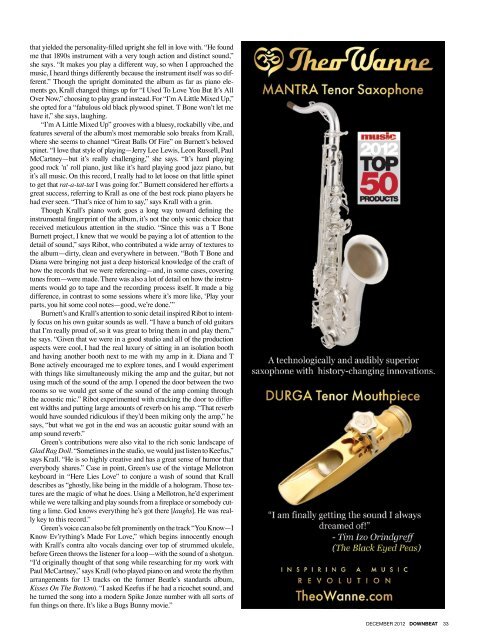Ron Carter Esperanza Spalding - Downbeat
Ron Carter Esperanza Spalding - Downbeat
Ron Carter Esperanza Spalding - Downbeat
You also want an ePaper? Increase the reach of your titles
YUMPU automatically turns print PDFs into web optimized ePapers that Google loves.
that yielded the personality-filled upright she fell in love with. “He found<br />
me that 1890s instrument with a very tough action and distinct sound,”<br />
she says. “It makes you play a different way, so when I approached the<br />
music, I heard things differently because the instrument itself was so different.”<br />
Though the upright dominated the album as far as piano elements<br />
go, Krall changed things up for “I Used To Love You But It’s All<br />
Over Now,” choosing to play grand instead. For “I’m A Little Mixed Up,”<br />
she opted for a “fabulous old black plywood spinet. T Bone won’t let me<br />
have it,” she says, laughing.<br />
“I’m A Little Mixed Up” grooves with a bluesy, rockabilly vibe, and<br />
features several of the album’s most memorable solo breaks from Krall,<br />
where she seems to channel “Great Balls Of Fire” on Burnett’s beloved<br />
spinet. “I love that style of playing—Jerry Lee Lewis, Leon Russell, Paul<br />
McCartney—but it’s really challenging,” she says. “It’s hard playing<br />
good rock ’n’ roll piano, just like it’s hard playing good jazz piano, but<br />
it’s all music. On this record, I really had to let loose on that little spinet<br />
to get that rat-a-tat-tat I was going for.” Burnett considered her efforts a<br />
great success, referring to Krall as one of the best rock piano players he<br />
had ever seen. “That’s nice of him to say,” says Krall with a grin.<br />
Though Krall’s piano work goes a long way toward defining the<br />
instrumental fingerprint of the album, it’s not the only sonic choice that<br />
received meticulous attention in the studio. “Since this was a T Bone<br />
Burnett project, I knew that we would be paying a lot of attention to the<br />
detail of sound,” says Ribot, who contributed a wide array of textures to<br />
the album—dirty, clean and everywhere in between. “Both T Bone and<br />
Diana were bringing not just a deep historical knowledge of the craft of<br />
how the records that we were referencing—and, in some cases, covering<br />
tunes from—were made. There was also a lot of detail on how the instruments<br />
would go to tape and the recording process itself. It made a big<br />
difference, in contrast to some sessions where it’s more like, ‘Play your<br />
parts, you hit some cool notes—good, we’re done.’”<br />
Burnett’s and Krall’s attention to sonic detail inspired Ribot to intently<br />
focus on his own guitar sounds as well. “I have a bunch of old guitars<br />
that I’m really proud of, so it was great to bring them in and play them,”<br />
he says. “Given that we were in a good studio and all of the production<br />
aspects were cool, I had the real luxury of sitting in an isolation booth<br />
and having another booth next to me with my amp in it. Diana and T<br />
Bone actively encouraged me to explore tones, and I would experiment<br />
with things like simultaneously miking the amp and the guitar, but not<br />
using much of the sound of the amp. I opened the door between the two<br />
rooms so we would get some of the sound of the amp coming through<br />
the acoustic mic.” Ribot experimented with cracking the door to different<br />
widths and putting large amounts of reverb on his amp. “That reverb<br />
would have sounded ridiculous if they’d been miking only the amp,” he<br />
says, “but what we got in the end was an acoustic guitar sound with an<br />
amp sound reverb.”<br />
Green’s contributions were also vital to the rich sonic landscape of<br />
Glad Rag Doll. “Sometimes in the studio, we would just listen to Keefus,”<br />
says Krall. “He is so highly creative and has a great sense of humor that<br />
everybody shares.” Case in point, Green’s use of the vintage Mellotron<br />
keyboard in “Here Lies Love” to conjure a wash of sound that Krall<br />
describes as “ghostly, like being in the middle of a hologram. Those textures<br />
are the magic of what he does. Using a Mellotron, he’d experiment<br />
while we were talking and play sounds from a fireplace or somebody cutting<br />
a lime. God knows everything he’s got there [laughs]. He was really<br />
key to this record.”<br />
Green’s voice can also be felt prominently on the track “You Know—I<br />
Know Ev’rything’s Made For Love,” which begins innocently enough<br />
with Krall’s contra alto vocals dancing over top of strummed ukulele,<br />
before Green throws the listener for a loop—with the sound of a shotgun.<br />
“I’d originally thought of that song while researching for my work with<br />
Paul McCartney,” says Krall (who played piano on and wrote the rhythm<br />
arrangements for 13 tracks on the former Beatle’s standards album,<br />
Kisses On The Bottom). “I asked Keefus if he had a ricochet sound, and<br />
he turned the song into a modern Spike Jonze number with all sorts of<br />
fun things on there. It’s like a Bugs Bunny movie.”<br />
DECEMBER 2012 DOWNBEAT 33
















